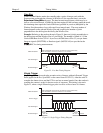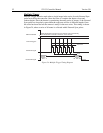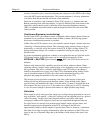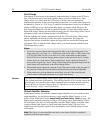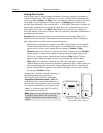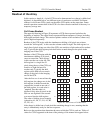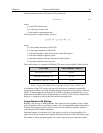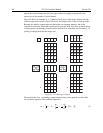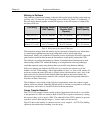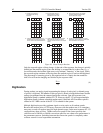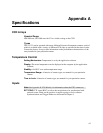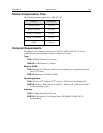
58 ST-133 Controller Manual Version 3.B
Readout of the Array
In this section, a simple 6 × 4 pixel CCD is used to demonstrate how charge is shifted and
digitized. As described below, two different types of readout are available. Full frame
readout, for full frame CCDs, reads out the entire CCD surface at the same time. Frame
transfer operation assumes half of the CCD is for data collection and half of the array is a
temporary storage area.
Full Frame Readout
The upper left drawing in Figure 28 represents a CCD after exposure but before the
beginning of readout. The capital letters represent different amounts of charge, including
both signal and dark charge. This section explains readout at full resolution, where every
pixel is digitized separately.
Readout of the CCD begins with the simultaneous shifting of all pixels one column
toward the "shift register," in this case the column on the far right. The shift register is a
single line of pixels along one side of the CCD, not sensitive to light and used for readout
only. Typically the shift register pixels hold twice as much charge as the pixels in the
imaging area of the CCD.
Readout of the CCD begins with the
simultaneous shifting of all pixels
one row toward the "shift register,"
in this case the row on the top. The
shift register is a single line of
pixels along the top of the CCD, not
sensitive to light and used for
readout only. Typically the shift
register pixels hold twice as much
charge as the pixels in the imaging
area of the CCD.
After the first row is moved into the
shift register, the charge now in the
shift register is shifted toward the
output node, located at one end of
the shift register. As each value is
"emptied" into this node it is
digitized. Only after all pixels in the
first row are digitized is the second
row moved into the shift register.
The order of shifting in our example
is therefore A1, B1, C1, D1, A2, B2,
C2, D2, A3....
1
A2
A1
B2
B1
C2
C1
D2
D1
A4
A3
B4
B3
C4
C3
D4
D3
A6
A5
B6
B5
C6
C5
D6
D5
A1 B1
C1 D1
4
A2
B1
B2
C1
C2
D1
D2
A4
A3
B4
B3
C4
C3
D4
D3
A6 B6
C6
D6
2
A2 B2 C2 D2
A4
A3
B4
B3
C4
C3
D4
D3
A6 B6
C6
D6
3
A2
A1
B2
B1
C2
C1
D2
D1
A4
A3
B4
B3
C4
C3
D4
D3
A6 B6
C6
D6
A5 B5 C5 D5
A5 B5 C5 D5 A5 B5 C5 D5
Figure 28. Full Frame at Full Resolution
After charge is shifted out of each pixel the remaining charge is zero, meaning that the
array is immediately ready for the next exposure.
Below are the equations that determine the rate at which the CCD is read out. Tables of
values for CCDs supported at the time of the printing of this manual also appear below.




